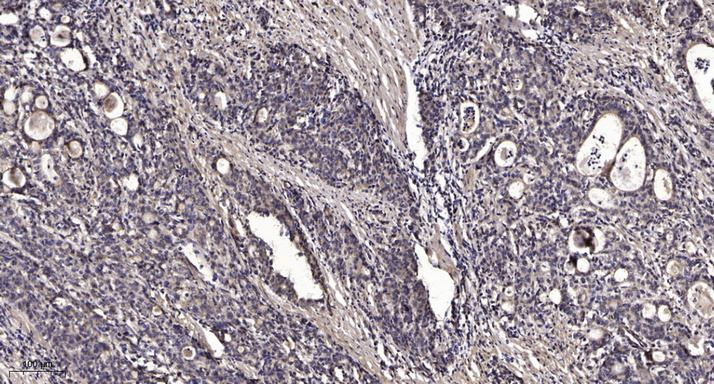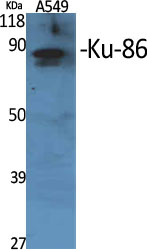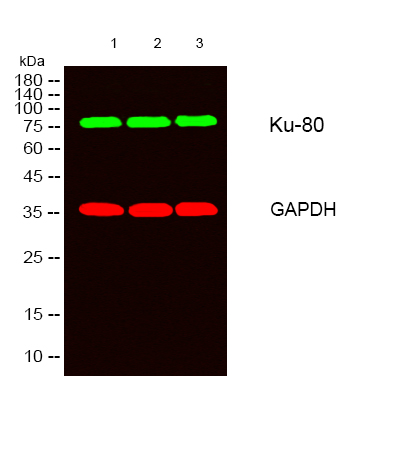SQSTM1/p62 (Phospho Ser349) rabbit pAb
- Catalog No.:YP1504
- Applications:WB;ELISA;IHC
- Reactivity:Human;Mouse
- Target:
- SQSTM1/p62
- Fields:
- >>Mitophagy - animal;>>Autophagy - animal;>>Necroptosis;>>Cellular senescence;>>Osteoclast differentiation;>>Amyotrophic lateral sclerosis;>>Pathways of neurodegeneration - multiple diseases;>>Shigellosis;>>Fluid shear stress and atherosclerosis
- Gene Name:
- SQSTM1 ORCA OSIL
- Protein Name:
- SQSTM1/p62 (Ser349)
- Human Gene Id:
- 8878
- Human Swiss Prot No:
- Q13501
- Mouse Gene Id:
- 18412
- Mouse Swiss Prot No:
- Q64337
- Rat Gene Id:
- 113894
- Rat Swiss Prot No:
- O08623
- Immunogen:
- Synthesized phosho peptide around human SQSTM1(Ser349)
- Specificity:
- This antibody detects endogenous levels of Human Mouse SQSTM1/p62 (phospho-Ser349)
- Formulation:
- Liquid in PBS containing 50% glycerol, 0.5% BSA and 0.02% sodium azide.
- Source:
- Polyclonal, Rabbit,IgG
- Dilution:
- WB 1:500-2000;IHC 1:50-300; ELISA 2000-20000
- Purification:
- The antibody was affinity-purified from rabbit serum by affinity-chromatography using specific immunogen.
- Concentration:
- 1 mg/ml
- Storage Stability:
- -15°C to -25°C/1 year(Do not lower than -25°C)
- Other Name:
- Sequestosome-1 (EBI3-associated protein of 60 kDa) (EBIAP) (p60) (Phosphotyrosine-independent ligand for the Lck SH2 domain of 62 kDa) (Ubiquitin-binding protein p62)
- Molecular Weight(Da):
- 48kD
- Observed Band(KD):
- 60kD
- Background:
- This gene encodes a multifunctional protein that binds ubiquitin and regulates activation of the nuclear factor kappa-B (NF-kB) signaling pathway. The protein functions as a scaffolding/adaptor protein in concert with TNF receptor-associated factor 6 to mediate activation of NF-kB in response to upstream signals. Alternatively spliced transcript variants encoding either the same or different isoforms have been identified for this gene. Mutations in this gene result in sporadic and familial Paget disease of bone. [provided by RefSeq, Mar 2009],
- Function:
- disease:Defects in SQSTM1 are a cause of sporadic and familial Paget disease of bone (PDB) [MIM:602080]. PDB is a metabolic bone disease affecting the axial skeleton and characterized by focal areas of increased and disorganized bone turn-over due to activated osteoclasts. Manifestations of the disease include bone pain, deformity, pathological fractures, deafness, neurological complications and increased risk of osteosarcoma. PDB is a chronic disease affecting 2 to 3% of the population above the age of 40 years.,domain:The OPR domain mediates homooligomerization and interactions with PRKCZ, PRKCI, MAP2K5 and NBR1.,domain:The UBA domain binds specifically 'Lys-63'-linked polyubiquitin chains of polyubiquitinated substrates. Mediates the interaction with TRIM55.,domain:The ZZ-type zinc finger mediates the interaction with RIPK1.,function:Adapter protein which binds ubiquitin and may regul
- Subcellular Location:
- Cytoplasm, cytosol . Late endosome. Lysosome. Cytoplasmic vesicle, autophagosome. Nucleus. Endoplasmic reticulum. Nucleus, PML body . Cytoplasm, myofibril, sarcomere . In cardiac muscle, localizes to the sarcomeric band (By similarity). Commonly found in inclusion bodies containing polyubiquitinated protein aggregates. In neurodegenerative diseases, detected in Lewy bodies in Parkinson disease, neurofibrillary tangles in Alzheimer disease, and HTT aggregates in Huntington disease. In protein aggregate diseases of the liver, found in large amounts in Mallory bodies of alcoholic and nonalcoholic steatohepatitis, hyaline bodies in hepatocellular carcinoma, and in SERPINA1 aggregates. Enriched in Rosenthal fibers of pilocytic astrocytoma. In the cytoplasm, observed in both membrane-free ubiqui
- Expression:
- Ubiquitously expressed.
- June 19-2018
- WESTERN IMMUNOBLOTTING PROTOCOL
- June 19-2018
- IMMUNOHISTOCHEMISTRY-PARAFFIN PROTOCOL
- June 19-2018
- IMMUNOFLUORESCENCE PROTOCOL
- September 08-2020
- FLOW-CYTOMEYRT-PROTOCOL
- May 20-2022
- Cell-Based ELISA│解您多样本WB检测之困扰
- July 13-2018
- CELL-BASED-ELISA-PROTOCOL-FOR-ACETYL-PROTEIN
- July 13-2018
- CELL-BASED-ELISA-PROTOCOL-FOR-PHOSPHO-PROTEIN
- July 13-2018
- Antibody-FAQs
- Products Images

- Immunohistochemical analysis of paraffin-embedded human Gastric adenocarcinoma. 1, Antibody was diluted at 1:200(4° overnight). 2, Tris-EDTA,pH9.0 was used for antigen retrieval. 3,Secondary antibody was diluted at 1:200(room temperature, 45min).

